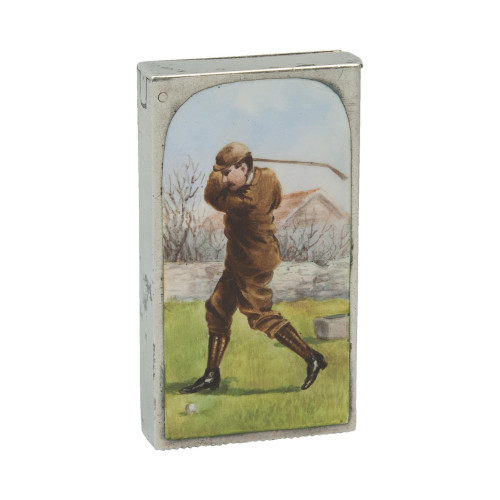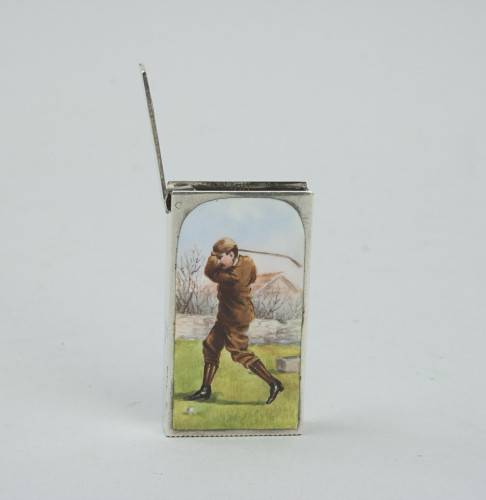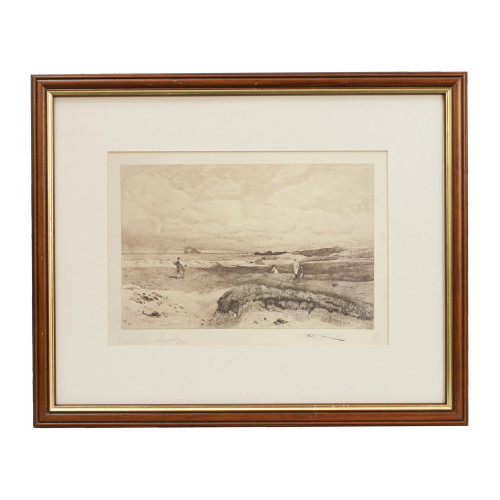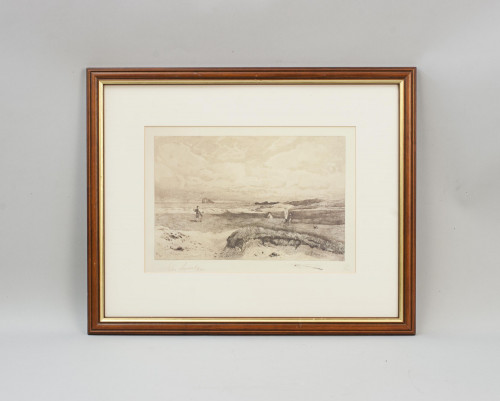- Home
- Golf
- Artwork, Paintings & Prints
- The 10th Green - King's Course, Gleneagles - Arthur Weaver Watercolour
The 10th Green - King's Course, Gleneagles - Arthur Weaver Watercolour
The 10th Green - King's Course, Gleneagles - Arthur Weaver Watercolour
30358
Arthur Weaver Golf Print of Gleneagles, Canty Lye, 10th Green.
An original watercolour painting by Arthur Weaver. Entitled '10th Green, King's Course, Gleneagles', 1978. The picture depicts the 10th hole, Canty Lye, with a golfer putting and a second stood behind watching. The King's Course, opened in 1919, was designed by James Braid a five times Open Champion and a member of the Great Triumvirate of the sport, together with J.H.Taylor and Harry Vardon.
taken from the Gleneagles website:-
The Gleneagles Hotel's Grand Opening Gala was on 7 June 1924 but its history commenced 14 years prior to that momentous day. In 1910 Donald Matheson, General Manager of the Caledonian Railway Company, was on holiday in Strathearn. His railway line ran through the valley and, as it was the era of 'Grand Hotels' he was so impressed by the surrounding countryside in Scotland that he conjured up the vision of a large country house hotel, built in the style of a palace which would provide leisure in the form of golf to the travelling public.
Perhaps this concept can best be described as "guests will travel on our trains, to stay in our hotel, to play golf on our courses". In keeping with his plans for the excellence of the concept, Donald Matheson looked for the best in the creation of two golf courses. He engaged James Braid, one of the golfing greats, to design and create the King's and Queen's Courses in the grounds of the hotel. Braid had won five Open Championships between 1901 and 1910 and then turned to golf course design. The King's and Queen's, created out of a wilderness using manual labour, pick and shovel, horse and cart, were ready much earlier than the hotel and began to make their name between 1918 and 1924.
The Gleneagles courses, although not by the sea, resemble the older links golf courses in Scotland in that they are built on sand and gravel, which were deposited when the last ice sheet finally melted some 15,000 years ago, leaving long ridges, flat-topped mounds and enclosed hollows. Braid turned this dramatic landscape into the King's and Queen's Courses. The result is an idyllic golfing landscape where many of the fairways and greens, particularly on the King's are isolated from neighbouring holes by the gravel ridges, so giving golfers the luxury of feeling they are playing on their own private course. The turf on these older courses is firm and springy and, therefore, never tiring to play on.
The summer of 1928 saw the opening of a third course of nine holes. This was known as 'The Wee Course' and was designed by the head greenkeeper, George Alexander. The Wee Course was lengthened to the full eighteen holes in 1974 and renamed Prince's. A fourth course, Glendevon, was opened in 1980.
When Jack Nicklaus created the Monarch's Course in the early 1990s it was over the eighteen holes of the Glendevon Course and some holes of the Prince's Course (the remaining holes of the Prince's Course were incorporated into a new nine-hole 'Wee Course', designed by the Gleneagles greenkeepers, recalling the original Wee Course of the 1920s). The Monarch's Course was renamed The PGA Centenary Course in February 2001 to celebrate the centenary year of The Professional Golfer's Association and is the selected venue for the 2014 Ryder Cup.
The King's Course, opened in 1919, is a masterpiece of golf course design, which has tested the aristocracy of golf, both professional and amateur. James Braid's plan for the King's Course was to test even the best players' shot-making skills over the eighteen holes. You find out all about it with your first approach shot. If you have driven straight and long from the tee, you will have what looks like a simple pitch to the elevated green. But you must be sure to select the correct club, because the shot is always a little longer than you think, with the wind over the putting surface often stronger than you can feel it from the fairway.
And if you do not make the severely sloping green, a bunker yawns twenty feet below. Selecting the right club for each approach shot is the secret on the King's. It is certainly one of the most beautiful and exhilarating places to play golf in the world, with the springy moorland turf underfoot, the sweeping views from the tees all around, the rock-faced mountains to the north, the green hills to the south, and the peaks of the Trossachs and Ben Vorlich on the western horizon. Readers of Celebrated Living, the luxury magazine for American Airlines, voted the King's Course 6th in their Platinum list of International Golf Courses.
All the holes have evocative and pithy Scots names. For example, the fifth, "Het Girdle" (Hot Pan), is a challenging par 3 with trouble everywhere except on the green, while 17th's name, "Warslin' Lea" (Wrestling Ground), reflects the difficulty so many golfers have had with this long, sweeping par 4.
Dimensions:
1950-1999
1978
Watercolour
United Kingdom
Arthur Weaver
Good original condition.
Thank you for your enquiry.
We will get back to you soon.
Please create wishlist to add this item to
RELATED ITEMS


































